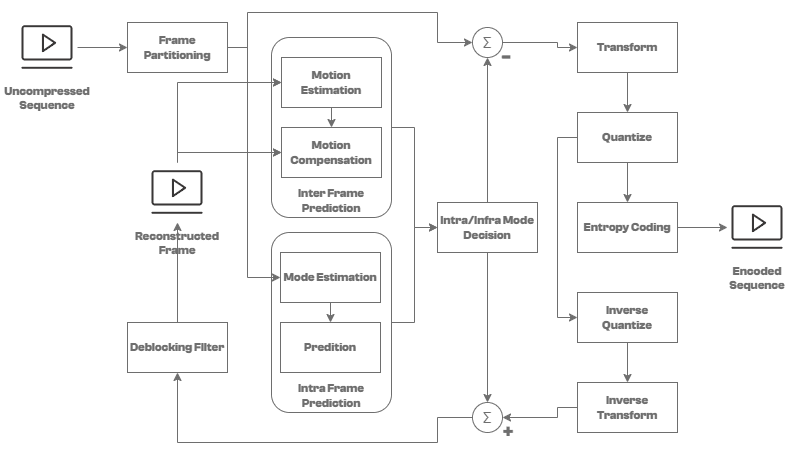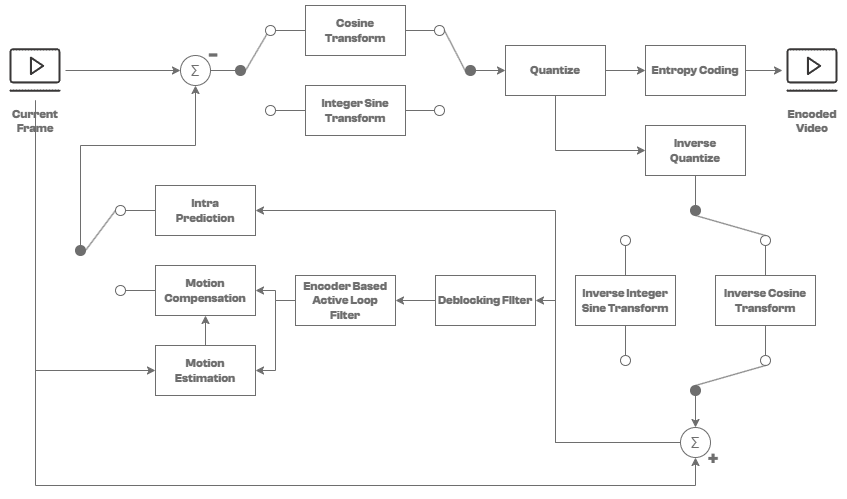We covered how AV1 compares to H.264 in our previous blog. In this one, we’ll look at which codec comes out on top in the fight between AV1 vs H.265. You’ll learn how they differ in efficiency, compatibility, live streaming readiness, and long-term value for streaming platforms. What is a Video Codec? Illustration of the… Continue reading AV1 vs H.265: Codec Comparison Guide [2025 Updated]
We covered how AV1 compares to H.264 in our previous blog. In this one, we’ll look at which codec comes out on top in the fight between AV1 vs H.265. You’ll learn how they differ in efficiency, compatibility, live streaming readiness, and long-term value for streaming platforms.
Table of Contents
What is a Video Codec?

Illustration of the video compression process.
A video codec is a software or hardware process that compresses or decompresses digital video. Video codecs are employed to reduce the size of video media to take-up less storage when archived and lower bitrates to stream; both yielding cost savings. When you watch a video online, the codec compresses it for sending and then decompresses it for viewing. Codecs are used in streaming, video calls, and everyday video playback.
What is AV1?
AV1 codec is a next-generation, royalty-free video compression standard developed by the Alliance for Open Media (AOMedia). It was designed to deliver significantly better compression efficiency than older codecs like VP9 and H.264 also called AVC, while maintaining high video quality across a wide range of resolutions and devices. AV1 reduces bandwidth consumption, making it ideal for modern streaming platforms, 4K and 8K video, and emerging immersive applications such as VR and AR.
How It Works
AV1 achieves superior compression by combining advanced prediction techniques, flexible partitioning, and enhanced filtering to reduce redundancy and improve visual fidelity. It is optimized for both streaming efficiency and playback performance, with hardware acceleration increasingly available in modern devices.

AV1 Encode Process Diagram.
Some of the key advancements include:
- Superior Compression Efficiency: AV1 reduces file sizes by 30–50% compared to VP9 and HEVC at equivalent video quality, lowering bandwidth requirements for high-resolution streaming.
- Scalable Resolution Support: AV1 supports everything from mobile video up to 8K and beyond, making it versatile for a wide range of use cases.
- Advanced Prediction Modes: AV1 improves intra-frame and inter-frame predictions, resulting in more accurate motion estimation and smoother playback.
- Flexible Block Partitioning: AV1 allows for dynamic block sizes down to 4×4 pixels and up to 128×128 pixels, adapting better to content complexity than previous codecs.
- Enhanced Parallel Processing: AV1 supports multi-threading and tiling, enabling faster encoding and decoding on multi-core systems.
- Improved Loop Filtering: Features like Constrained Directional Enhancement Filter (CDEF) and Loop Restoration Filter reduce compression artifacts and improve visual quality.
What is H.265?
H.265 codec, also called High Efficiency Video Coding or HEVC for short, is a video compression standard designed as the successor to H.264 (AVC). It roughly doubles the compression efficiency compared to H.264, allowing equivalent video quality at about half the bitrate, or significantly improved quality at the same bitrate. HEVC supports resolutions up to 8K (8192×4320), higher frame rates, wider color gamuts, and high dynamic range (HDR) content, making it well-suited for modern streaming, broadcasting, and storage applications.
How It Works
HEVC improves upon the compression efficiency of H.264 (AVC) by adding algorithms that reduce the size of the video content by around 50%. It uses coding tree units (CTUs), which can be substantially larger than the macroblocks used in H.264. This allows for more efficient data organization and compression, particularly for high-resolution videos. Overall, HEVC introduces improved intra-frame prediction, sophisticated entropy coding, and advanced motion vector prediction mechanisms. These innovations collectively contribute to HEVC’s ability to deliver unparalleled compression efficiency without sacrificing video quality.

H.265 Encode Process Diagram.
Some of the key advancements include:
- Superior Compression Efficiency: H.265 offers up to 50% better compression than H.264, reducing file sizes while maintaining the same video quality. This makes it especially valuable for 4K and 8K streaming.
- Coding Tree Units (CTUs): Instead of fixed 16×16 macroblocks, H.265 uses flexible CTUs up to 64×64 pixels, enabling more efficient data organization and compression.
- Enhanced Motion Prediction: H.265 introduces more advanced motion vector prediction and partitioning, improving video quality in fast-moving scenes.
- Parallel Processing: The codec supports tile and wavefront parallel processing, dividing frames into regions that can be encoded simultaneously, boosting speed and efficiency.
- Expanded Resolution Support: H.265 is designed for ultra-high-definition video, supporting 4K, 8K, and beyond with better bandwidth efficiency.
- Error Resilience and Adaptability: Built-in tools help maintain stream quality under challenging network conditions, making it reliable for live and on-demand streaming.
AV1 vs H.265
| Point of Comparison | H.265 (HEVC) | AV1 | Winner |
| Release Year | 2013 | 2018 | AV1 |
| Encoding Quality | 4K/8K capable, high compression efficiency | 4K/8K capable | H.265 |
| Encoding Time | Moderate (faster than AV1) | Slow (improving) | H.265 |
| CPU Consumption | Moderate CPU use; good hardware support (Windows, Apple, Android) | High | H.265 |
| Adoption & Browser Implementation | Adoption slowed by licensing; Chrome supports hardware decoding | Growing rapidly | AV1 |
| Bandwidth Savings | Excellent compression and low bandwidth use. CPU load increases with higher efficiency. | Very good compression and low bandwidth. CPU bears the impact for the savings | AV1 |
| Licensing and Accessibility | Managed by multiple patent pools (MPEG-LA, Velos Media, HEVC Advance); requires licensing fees; more costly, limiting adoption | Open-source, royalty-free | AV1 |
| Supported Streaming Protocols | Supports HLS, MPEG-DASH, RTSP, SRT; limited WebRTC/browser support due to licensing and often requiring hardware support | WebRTC, Enhanced RTMP, YouTube, HLS, DASH. | AV1 |
| Live Streaming Ready | Yes | Yes | H.265 |
Codec Comparison sheet AV1 vs HEVC
1. Release year
- AV1, finalized in 2018, incorporates advanced compression techniques developed by the Alliance for Open Media. This consortium includes industry giants like Google, Mozilla, Netflix, Amazon, and Apple, ensuring broad industry support for the standard.
- H.265 (HEVC), standardized in 2013 by the ITU-T and ISO/IEC, succeeded H.264 with improved compression efficiency and support for higher resolutions like 4K and 8K. It became widely adopted for UHD broadcasts, streaming, and video storage due to its ability to deliver comparable quality at about half the bitrate of H.264.
Winner: AV1.
2. Encoding Quality
- AV1 codec performance: Rapidly improving software optimizations. Quality gains and overall bandwidth savings often justify computational cost for many applications.
- H.265 (HEVC) codec performance: Delivers excellent visual quality with mature encoder implementations. While AV1 can achieve slightly better efficiency at lower bitrates, H.265 offers faster encoding and comparable results for most 4K and 8K workflows.
Winner: H.265.
3. Encoding Time
- AV1 codec performance: Significantly higher computational complexity (5–10× slower than VP9, but improving with newer software and hardware acceleration).
- H.265 codec performance: Encoding is slower and more computationally intensive than H.264 but faster than AV1. Hardware acceleration support is now widespread, making it practical for high-resolution streaming and VOD workflows.
Winner: H.265.
4. CPU Consumption
- AV1 encoding and software decoding are significantly more CPU intensive than VP9, making it more suitable for offline or server-side encoding rather than real-time on devices lacking hardware support.
- H.265 Consumes less CPU than AV1 for both encoding and decoding, especially when hardware acceleration is available. While still demanding for software-only processing, it offers a more balanced trade-off between efficiency and computational load.
Winner: H.265.
5. Adoption & Browser Implementation
- AV1: Supported in Chrome, Firefox, Edge, and recent Safari builds (macOS 16 / iOS 16+) when hardware decoding is present. AV1 playback is supported on Android 10+ devices with hardware decoders, and smart TV manufacturers such as Samsung, LG, and Sony include AV1 support in models released from 2020 onward.
- H.265 is supported across most modern devices and operating systems with hardware decoding. All major browser engines are actively working on implementing HEVC, though current support is still limited. It’s available on macOS (High Sierra and later), Android (5.0+), and Windows devices with hardware support or with the HEVC Video Extensions installed from the Microsoft Store. Firefox and Edge offer partial support depending on OS and hardware configuration.
Winner: AV1.
6. Bandwidth Savings
The biggest advantage to increased compression rates and the resulting smaller file sizes is that video consumes less bandwidth when you broadcast it. This means that users with slower internet speeds are not limited by their internet connection and can still enjoy high-quality video streams.
- AV1: Delivers the strongest bandwidth savings of the three codecs, with compression efficiency improvements of 30–50% over VP9. This efficiency makes AV1 ideal for 4K, 8K, and HDR content, as it provides higher video quality at lower bitrates, helping streaming services scale while reducing delivery costs.
- H.265: Offers excellent compression efficiency and strong bandwidth savings, though slightly less than AV1. It can reduce bitrate requirements by up to 50% compared to older codecs, making it well-suited for 4K and 8K streaming where maintaining quality with lower data rates is critical.
Winner: AV1.
7. Licensing and Accessibility
- AV1: Backed by the Alliance for Open Media, AV1 is open source and royalty-free. It was designed to be an industry-standard codec that removes licensing barriers for modern video applications, giving developers and providers an advanced option for delivering high-quality, bandwidth-efficient video without additional costs.
- H.265 (HEVC): Governed by multiple patent pools, H.265 requires licensing fees for most commercial applications. While it delivers strong technical performance, its fragmented and costly licensing structure has slowed widespread adoption compared to AV1’s open and royalty-free model.
Winner: AV1.
8. Supported Streaming Protocols
- AV1 codec is supported in modern streaming workflows such as MPEG-DASH and HLS with CMAF packaging. AV1 integration into WebRTC is mature, and support for RTSP is not available. Recently RTMP gained support for AV1 via Enhanced RTMP.
- H.265 codec supports HLS, MPEG-DASH, RTSP, SRT; limited WebRTC/browser support due to licensing and often requiring hardware support.
Winner: H.265.
9. Live Streaming Ready
- AV1: Still developing in the live streaming space. While it delivers excellent compression efficiency, AV1 encoding remains too resource-intensive for real-time applications.
- H.265: Fully established by 2025. Well-suited for live streaming, offering stable performance and broad hardware encoder support. It achieves ultra-low latency delivery at high resolutions, making it a reliable choice for real-time broadcasts where AV1’s encoding complexity still poses challenges.
Winner: H.265.
What Video Codec To Choose Between AV1 and H.265?

AV1 vs H.265
- If you need a future-ready solution for premium applications where maximum bandwidth efficiency and next-generation quality are critical, choose AV1. Although it carries a higher initial encoding cost, savings of 30–50% in bandwidth and growing hardware acceleration make it a strong long-term option for high-volume streaming.
- If you need broad compatibility, fast encoding, and reliable real-time performance across most devices and platforms, but you’re not requiring full WebRTC browser support, choose H.265 (HEVC). It’s fully established by 2025 for live streaming, widely supported by hardware encoders, and offers excellent quality at lower bitrates. However, it requires licensing fees and doesn’t yet match AV1’s open, royalty-free accessibility.
How to Migrate from HEVC to AV1?

An Indian developer migrates from the H.265 video codec to AV1.
Current HEVC (H.265) workflows can gradually adopt AV1:
Phase 1: Assessment
- Evaluate current H.265 performance and bandwidth usage.
- Test AV1 encoding with representative content at different bitrates.
- Assess target audience device and browser support.
- Calculate potential delivery cost savings from bandwidth reduction.
Phase 2: Hybrid Deployment
- Deploy AV1 for supported devices with H.265 fallback.
- Monitor quality, encoding time, and playback performance across both codecs.
- Optimize encoding settings separately to maximize efficiency.
- Increase AV1 usage as hardware and software support expands.
Phase 3: Full AV1 Adoption
- Transition primary encoding workflows to AV1 where broadly supported.
- Retain H.265 as a legacy fallback for maximum device compatibility.
- Implement adaptive codec selection to automatically serve the best option.
- Track long-term performance and cost benefits of AV1 at scale.
AV1 codec support in Red5 Pro and Red5 Cloud is coming early 2026. Get in touch with us today to join the waitlist and be among the first to try it.
Conclusion
AV1 delivers unmatched compression efficiency and long-term bandwidth savings, but at the cost of higher computational demand and slower encoding. H.265 offers a strong balance between quality, efficiency, and real-time performance, making it a practical choice for most current streaming workflows. For future scalability, AV1 is worth adopting gradually while maintaining H.265 for established infrastructure and broad device compatibility.
FAQs
Which is better: AV1 vs H265?
AV1 delivers superior compression efficiency, reducing bandwidth use by up to 30–50% compared to H.265, making it ideal for 4K, 8K, and next-generation streaming. However, H.265 offers faster encoding, mature hardware support, and reliable performance for real-time applications. The better choice depends on whether you prioritize long-term efficiency and open licensing (AV1) or established compatibility and lower encoding complexity (H.265).
Does Red5 support H.265 and AV1 codecs?
Yes. Red5 Pro and Red5 Cloud fully support H.265. AV1 support is coming in early 2026, giving you access to advanced compression and bandwidth savings. Get in touch with us today to join the waitlist and be among the first to try it.
How to migrate from H.265 codec to AV1?
Migration is best done in phases. Start by evaluating H.265 performance and testing AV1 encoding on sample content to calculate savings. Next, deploy AV1 for supported devices while keeping H.265 fallback to maintain compatibility. Gradually increase AV1 usage as hardware support grows. Eventually, transition to AV1 as the primary codec while retaining H.265 for legacy viewers.
Try Red5 For Free
🔥 Looking for a fully managed, globally distributed streaming PaaS solution? Start using Red5 Cloud today! No credit card required. Free 50 GB of streaming each month.
Looking for a server software designed for ultra-low latency streaming at scale? Start Red5 Pro 30-day trial today!
Not sure what solution would solve your streaming challenges best? Watch a short Youtube video explaining the difference between the two solutions, or reach out to our team to discuss your case.
Product marketing manager with experience at software companies, startups, and enterprises in the live streaming industry since 2018. Her core expertise is SEO, but she also collaborates closely with the product development team to integrate marketing into Red5 solutions and drive adoption. She supports growth through go-to-market strategies, release announcements, email campaigns, case studies, sales enablement materials, social media, and other channels.

